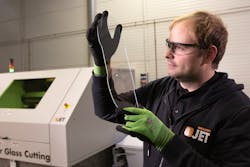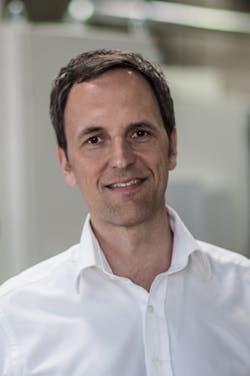Keeping laser surface processing business scalable
Antonio Castelo: What’s the backstory behind your role as CEO at 4JET?
Joerg Jetter: I started out studying law and economics and worked as an intern for an automotive company in their marketing department. But after a couple of years, I dropped out to help my father run his small engineering company that had been pioneering laser surface cleaning since the early 1990s. I worked for him as a freelancer for a couple of years, then I took over his team as the core of my business. At that time, the company consisted of a small team of engineers, and although the technology was great, I decided to change the business model by turning the company into a product business known as 4JET.Castelo: How has 4JET evolved?
Jetter: We started out providing laser-based tire-processing machines for cleaning tire molds. A year later, we entered the thin-film photovoltaics (PV) industry, supplying laser patterning and other laser processing systems to manufacture thin-film solar cells. With the financial crisis in 2008, the automotive industry virtually collapsed, but we were able to survive with revenues from our PV business.
But in 2011, the European solar manufacturing industry collapsed and we lost 80% of our customers within a year. So we basically had to reinvent the company. On the tire industry side, we did this by developing a system to enable the traceability of tires throughout their life cycle by machine-readable QR codes. On the PV side, we went global as quickly as we could by entering the Asian market at a time when most European equipment vendors had pulled out. But we kept on and have been working with Asian and Western customers alike for the last decade, and we now see significant volume opportunities in Asia for PV manufacturing.
Today, PV and tire processing remain our key markets, together with cutting or ablating thin layers on glass for displays, semiconductors, and other applications. Our business model is technology-heavy system integration: we develop production solutions that customers use to process their parts at an industrial scale. 80% of our revenue is selling machinery that is used in 24/7 operations in manufacturing plants around the globe. Rather than focusing on individual or customized solutions, we develop products that serve a special need and that we can sell in a repeat way to reach a certain scalability and repeatability in the business.
We are headquartered in Germany, and we have small subsidiaries in Atlanta (Georgia, U.S.) and Shanghai for sales and service. We also operate a laser processing job shop especially for glass machining. During the past 17 years, the group has grown to a workforce of about 180 with annual sales of more than €30 million.
Castelo: Do you build the lasers yourself or buy them from a third party?
Jetter: We decided early on that to keep up with the technological developments in laser sources and to be able to build world-class equipment, we would buy lasers from third parties and focus on the integration. We always think of the laser as the engine, and our role is to build the car.
Castelo: Has not having a background in photonics or engineering been a challenge?
Jetter: Not at all. In fact, it’s been an advantage because very early on, I knew I needed to have a very capable technical team supporting me. As a result, I hire talented people and never get in their way. I think a lot of tech companies are founded by technologists who have an opinion on everything happening on the technical side and who maybe don’t give their teams room to evolve. In my case, my nontechnical background has meant there have never been any turf wars, which has accelerated our development.
Castelo: How is your company different than the competition?
Jetter: We can now meet extremely high precision requirements on very large substrates up to 2 × 3 meters, and we process them with a repeat accuracy within the single-micron range, with extremely high dynamics. In glass cutting, we have processes that run at 1 meter per second, with a repeat accuracy of 2 µm, so combining dynamics and precision is one of our key competencies. We have also developed equipment to enable extremely short cycle times, such as processing windshields, where the cycle time is below 20 seconds. And we have applications in the solar space where the cycle time for a large sheet of glasses is below 15 seconds, with material handling times of only a few seconds.
Castelo: How important is R&D for you?
Jetter: We’re very R&D-heavy, with more than 80 engineers or Ph.D.s, including 25 people developing laser processes and about 20 software developers. Our R&D spend is typically 12% of revenue, and we’re very active in securing intellectual property.
Castelo: Do you participate in any European R&D projects?
Only on a very limited scale. Many companies are too dependent on subsidies or grants. We usually have a very clear understanding of what markets we want to approach and, if we see a business case for developing a product, we just do it and don’t wait for lengthy approval processes of subsidies or grants. I’ve seen quite a few companies get hooked on R&D grants, which I don’t think is healthy. If half of your bottom line comes from the government, it’s a problem.
Castelo: What’s your vision for the future?
Jetter: In the automotive realm, several things relevant to surface processing for battery manufacturing are in our R&D pipeline. Also, the shift to e-mobility is having a huge impact on the way car tires are built so that suddenly tires are the noisiest component on a car. As a result, the tire industry is looking for ways to reduce the rolling noise in the car by installing noise-depressing foams, which requires the tire to be cleaned beforehand. This is a good business for us.
In more general terms, we envision a 4JET surface in everyone’s life, because sooner or later we will all either have a 4JET processed solar cell on our roof, or some 4JET technology in a foldable smartphone, in our car, or on our tires.
One of the interesting things we are working on is to create fuel-saving shark skins on the outside of aircraft via laser interference patterning to enable green aviation. Going forward, we will continue to grow simply because we solve real-world problems like making industrial production less energy-intensive, enabling new solar cells, enabling e-mobility, and a lower fuel burn of airplanes.
Castelo: What’s your advice for the next generation of entrepreneurs?
Jetter: First, try to sell your technology as quickly as possible. It may not be perfectly mature, but you need to go out and get customers, and you need somebody to pay you. Too many companies spend too long developing their technology without customer feedback. It’s important to talk to customers—not so they can take over your development agenda, but so you can sound out if your technology can meet real market needs.
Second, don’t be afraid to ask for advice. There are many people you can call who have gone through a similar process and are happy to share their experiences.
Third, it may take 10, 15, or 20 years, but almost all good technologies eventually make it to the market. Don’t get frustrated if things take longer than you anticipate. For example, the hype around 3D printing started 10 years ago, but it’s only now that people are earning money from the technology. And laser cleaning, which is super-hot these days, was initiated by my father in the early 1990s, which was 30 years ago.
About the Author
Antonio Castelo
Antonio Castelo is Technology Manager for Bio-Medical and Lasers at the European Photonics Industry Consortium (EPIC).

